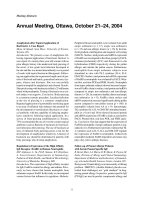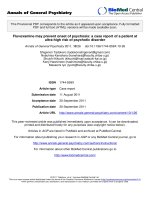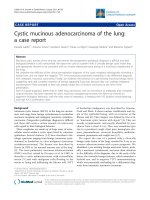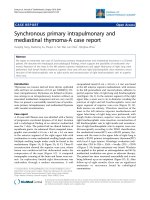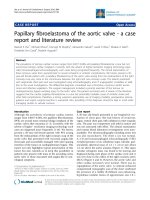Báo cáo y học: "Uterine primitive neuroectodermal tumor with adenosarcoma: a case report" potx
Bạn đang xem bản rút gọn của tài liệu. Xem và tải ngay bản đầy đủ của tài liệu tại đây (709.69 KB, 4 trang )
JOURNAL OF MEDICAL
CASE REPORTS
Bhardwaj et al. Journal of Medical Case Reports 2010, 4:195
/>Open Access
CASE REPORT
© 2010 Bhardwaj et al; licensee BioMed Central Ltd. This is an Open Access article distributed under the terms of the Creative Commons
Attribution License ( which permits unrestricted use, distribution, and reproduction in
any medium, provided the original work is properly cited.
Case report
Uterine primitive neuroectodermal tumor with
adenosarcoma: a case report
Minakshi Bhardwaj
1
, Meenakshi Batrani*
1
, Indu Chawla
2
and Renuka Malik
2
Abstract
Introduction: Primitive neuroectodermal tumor of the uterus is extremely rare. They occur as either pure primitive
neuroectodermal tumors or admixed with neoplasms of mullerian origin.
Case presentation: A case of uterine primitive neuroectodermal tumor with adenosarcoma in a 50-year-old Asian
Indian woman is presented. Histologically, the neoplasm displayed perivascular pseudorosettes and occasional Homer-
Wright rosettes. A strong positivity for neuronspecific enolase and synaptophysin was noted, while chromogranin and
CD99 were negative. Merging imperceptibly with the neuroectodermal components were the areas of adenosarcoma.
Conclusion: To the best of our knowledge, this report represents the second case of a uterine primitive
neuroectodermal tumor with an admixed adenosarcoma.
Introduction
The term "primitive neuroectodermal tumor" (PNET)
was first coined in 1973 by Hart and Earle to describe a
group of tumors thought to be derived from fetal neu-
roectodermal cells. These tumors were noted to have
morphological features of small round cell tumors with
variable degrees of neural, glial, and ependymal differen-
tiation [1].
There are two main categories of PNETs according to
the cell of origin and location: central and peripheral.
Central PNETs are derived from the neural tube and
involve mainly the brain and the spinal cord. On the other
hand, peripheral PNETs are derived from the neural crest
and occur outside the central nervous system, often
involving the sympathetic nervous system or soft tissues
and bones [2]. Peripheral PNETs show typical EWSR1
gene rearrangement, while central PNETs lack the
EWSR1 rearrangement [3].
Based on similar clinical, immunohistochemical and
cytogenetic profile, Ewing's sarcoma and PNET are
regarded as two extremes of a morphological spectrum of
the same tumor entity [2]. The occurrence of PNETs in
visceral sites such as lung, kidney and genital tract of a
woman has been increasingly recognized [3]. Here we
present a case of uterine PNET.
Case presentation
A 50-year-old Asian Indian woman, who had been meno-
pausal for two years, presented with complaints of post-
menopausal bleeding for three to four months. A per
speculum examination of our patient showed a 10×8 cm
vascular congested mass abutting the introitus. A poly-
poidal mass with a thick pedicle was felt coming out of
her endocervix on per vaginum examination.
Cervical polypectomy was done on our patient and a
histopathological diagnosis of small round cell tumor was
arrived at. Following polypectomy our patient continued
to have vaginal bleeding. Ultrasonography (USG) and
magnetic resonance imaging (MRI) of the whole abdo-
men and pelvis of our patient revealed an irregular infil-
trative mass lesion in her uterine corpus and cervix. No
parametrial invasion or significant lymphadenopathy,
however, was noted. Subsequently, a total abdominal hys-
terectomy with bilateral salpingo-oophorectomy with
pelvic omentectomy and pelvic lymph node sampling was
done on our patient. Her uterus and the cervix grossly
measured 8×4×3 cm. On cut surface a polypoidal, soft,
tan tumor, was seen filling her entire endometrial cavity
and extending to her endocervix.
Histology revealed a tumor with majority of the areas
displaying primitive neuroectodermal differentiation and
a minor component of adenosarcoma constituting
around 20% of the tumor volume. The former was com-
posed of sheets of undifferentiated, small round to oval
* Correspondence:
1
Department of Pathology, Dr. Ram Manohar Lohia Hospital, New Delhi, India
Full list of author information is available at the end of the article
Bhardwaj et al. Journal of Medical Case Reports 2010, 4:195
/>Page 2 of 4
cells with hyperchromatic nuclei and numerous mitotic
figures. Micronodular pale islands with fibrillary matrix,
perivascular pseudorosettes and occasional Homer-
Wright rosettes were seen (Figure 1). Areas of adenosar-
coma comprised of epithelial lined cleft-like spaces and
glands showing mild atypia and occasional mitosis along
with sarcomatous stroma and polypoidal stromal projec-
tions into the lumen (Figure 2). These glandular struc-
tures were present well away from the residual
endometrium and were not accompanied by the normal
endometrial stroma. Lymphovascular emboli were also
seen. The tumor showed full thickness myometrial inva-
sion and extension into the cervix. Left parametrium also
showed tumor infiltration and one left external iliac
lymph node showed metastasis.
On immunohistochemistry (IHC), both spindle cell
component of the adenosarcoma and small cell compo-
nent were positive for vimentin. The small cell compo-
nent also showed strong positivity for neuronspecific
enolase (NSE), and synaptophysin (Figure 3). Chro-
mogranin and cytokeratin examination results were
negative. CD99 was also negative. A final diagnosis of
stage IIIC PNET with adenosarcoma of the uterus was
finally made.
Two months post-operatively, our patient again pre-
sented with bleeding per vaginum and a nodule at the
vaginal vault. Her whole abdomen computed tomography
(CT) scan showed normal upper abdomen with a 2×2-cm
mass at the vaginal vault. She was then started on radio-
therapy and chemotherapy. Until her last follow-up
examination at six months after her surgery, our patient
has received a total of three cycles of radiotherapy and six
cycles of chemotherapy. Her vault nodule has been com-
pletely regressed and she is now disease-free.
Discussion
PNETs in the woman's genital tract are extremely rare
[2].The most common site of PNET in the woman's geni-
tal tract is the ovary. The uterine corpus is the next com-
mon site, while the cervix and the vulva are rarely the
primary site [4]. There are 43 cases of uterine PNETs
reported in the literature to date [2-6].
Uterine PNETs most commonly occur as pure PNETs.
An admixture with neoplasms of unquestionable mulle-
Figure 1 Primitive neuroectodermal tumor areas showing diffuse sheets of cells at (A) hematoxylin and eosin staining at ×100 magnifica-
tion, (B) hematoxylin and eosin staining at ×400 magnification. (C) Fibrillary nodules (hematoxylin and eosin staining, at ×40 magnification). And
(D) perivascular rosettes (hematoxylin and eosin staining, ×100 magnification) are also shown.
Bhardwaj et al. Journal of Medical Case Reports 2010, 4:195
/>Page 3 of 4
rian origin suggests a mullerian derivation for at least
some of these tumors [1]. Of the 43 cases of uterine
PNETs reported in the literature, 12 were associated with
a mullerian neoplasm. Of these, the most common occur-
rence was endometrial carcinoma at six cases, followed
by malignant mixed mullerian tumor (MMMT) at three
cases, and a case each of complex hyperplasia, endome-
trial stromal sarcoma and adenosarcoma [1,3]. The case
we present in this report is only the second reported case
of uterine PNET associated with adenosarcoma.
The glands within an adenosarcoma appear to be an
integral part of the neoplasm but dissimilar histological
appearances can result if non-neoplastic endometrial
glands become entrapped within a stromal sarcoma.
When entrapment of this type does occur, the glands are
commonly hyperplastic. It will usually also be apparent
that some are set in a non-neoplastic stroma that is being
encroached upon by a malignant stromal component.
Also, the presence of glandular structure away from any
residual endometrium and its absence from the pedicle of
the neoplasm helps to differentiate it from benign
entrapped glands [7]. Other characteristic morphological
features of adenosarcoma that help in diagnosis include
the presence of periglandular stromal cellularity and
stromal polypoid projections [8].
Uterine PNETs occur most commonly in patients older
than 50 years, and vaginal bleeding is the most common
presentation [3]. Histologically, PNETs have areas dis-
playing various types of neuroectodermal elements like
fibrillary background, ganglion cells, astrocyte-like cells,
rosettes, ependymal and medulloepithelial differentiation
[1,3]. Fibrillary background and rosette-like structures
are the most commonly observed patterns of neuroecto-
dermal differentiation [3]. On IHC most of the uterine
PNETs are variably positive for one or more neuroecto-
dermal markers like NSE, chromogranin, and synapto-
physin, while cytokeratin ranges from negative to very
focally positive [3]. In the largest case series on uterine
PNETs by Eusher et al., CD99 was positive in seven out of
nine cases tested for the marker. Also in their series none
of the 12 cases tested for typical EWSR1 rearrangement
Figure 2 Adenosarcoma composed of (A) glands with polypoidal stromal projections into the lumen (hematoxylin and eosin staining,
×40), (B) cleft-like epithelial lined spaces with sarcomatous stroma (hematoxylin and eosin staining, ×40), and (C) endometrial glands sur-
rounded by sarcomatous stroma (hematoxylin and eosin staining, ×40).
Figure 3 Immunostains showing (A) neuronspecific enolase positivity and (B) synaptophysin positivity.
Bhardwaj et al. Journal of Medical Case Reports 2010, 4:195
/>Page 4 of 4
were positive [3]. However, five cases of typical gene rear-
rangement are described in the literature [3,4].
The differential diagnosis of uterine PNETs include
other uterine tumors or tumor-like lesions containing
neuroectodermal elements of the type found in the cen-
tral nervous system. These include mature glial tissue in
the endocervix or endometrium, immature teratoma with
glial tissue, pure uterine gliomas, MMMT with neuroec-
todermal differentiation, and retinal anlage tumor.
Another group of differential diagnosis includes uterine
tumors with small malignant cell population. This group
includes rare endometrial carcinomas resembling small
cell carcinoma of the lung, endometrial stromal sarcoma,
malignant lymphoma, and leukemia. The diagnosis of
uterine PNET is based on light microscopic and immuno-
histochemical evidence of neuroectodermal differentia-
tion [2].
Uterine PNET, occurring as pure or in combination
with other histological subtype, is associated with
advanced-stage disease and follows a potentially aggres-
sive clinical course [3]. Multimodal treatment including
surgery, chemotherapy, and/or radiotherapy are required
[3].
Conclusion
Awareness of the occurrence of PNET in the uterus and
its recognition is important to distinguish it from other
tumors that may possess a different behavior and treat-
ment
Consent
Written informed consent was obtained from our patient
for publication of this case report and any accompanying
images. A copy of the written consent is available for
review by the Editor-in-Chief of this journal.
Competing interests
The authors declare that they have no competing interests.
Authors' contributions
MBH made the pathological diagnosis and was responsible for conception and
final approval of the manuscript. MB carried out the literature search and
drafted the manuscript. IC carried out the surgical procedure and reviewed the
manuscript. RM carried out the surgical procedure, provided clinical details, fol-
lowed up our patient and obtained her consent to publish this case report. All
authors read and approved the final manuscript.
Author Details
1
Department of Pathology, Dr. Ram Manohar Lohia Hospital, New Delhi, India
and
2
Department of Obstetrics and Gynecology, Dr. Ram Manohar Lohia
Hospital, New Delhi, India
References
1. Daya D, Lukka H, Clement PB: Primitive neuroectodermal tumors of the
uterus: A report of four cases. Hum Pathol 1992, 23(10):1120-1129.
2. Park JY, Lee S, Kang HJ, Kim HS, Park SY: Primary Ewing's sarcoma-
primitive neuroectodermal tumor of the uterus: a case report and
literature review. Gynecol Oncol 2007, 106:427-432.
3. Euscher ED, Deavers MT, Lopez-Terrada D, Lazar AJ, Silva EG, Malpica A:
Uterine tumors with neuroectodermal differentiation: a series of 17
cases and review of the literature. Am J Surg Pathol 2008, 32(2):219-221.
4. Blattner JM, Gable P, Quigley MM, McHale MT: Primitive
neuroectodermal tumor of the uterus. Gynecol Oncol 2007,
106:419-422.
5. Akbayir Q, Gungorduk K, Rafiolu A: Primary primitive neuroectodermal
tumor of the uterus: a case report. Arch Gynecol Obstet 2008,
277:345-348.
6. Celik H, Gurates B, Karaoglu A, Yavuz A, Dagli F, Ozercan R: Uterine
primitive neuroectodermal tumor: a case report. Arch Gynecol Obstet
2009, 279:259-261.
7. Fox H, Harilal KR, Youell A: Mullerian adenosarcoma of the uterine body:
a report of nine cases. Histopathology 1979, 3(3):167-180.
8. Clement PB, Scully RE: Mullerian adenosarcoma of the uterus: a
clinicopathological analysis of 100 cases with review of literature. Hum
Pathol 1990, 21:363-381.
doi: 10.1186/1752-1947-4-195
Cite this article as: Bhardwaj et al., Uterine primitive neuroectodermal
tumor with adenosarcoma: a case report Journal of Medical Case Reports
2010, 4:195
Received: 4 November 2009 Accepted: 28 June 2010
Published: 28 June 2010
This article is available from: 2010 Bhardwaj et al; licensee BioMed Central Ltd. This is an Open Access article distributed under the terms of the Creative Commons Attribution License ( ), which permits unrestricted use, distribution, and reproduction in any medium, provided the original work is properly cited.Journal of Medical Case Reports 2010, 4:195
